They look stylish and do not take up extra space - underfloor heating convectors
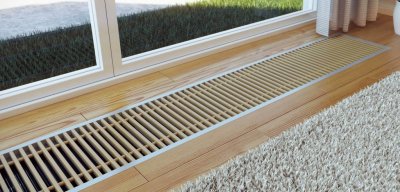
Floor convectors - These are heating devices that are built into the floor.
That's why they are also called built-in. This development is considered innovative - it was invented 20 years ago.
Content
Floor heating convectors: what are they

In a few words, the device can be described as follows: If you are planning to have panoramic floor-to-ceiling windows in your house or apartment, built-in convectors are your heating system option.
Because there will simply be nowhere to install traditional radiators and even ordinary convectors.
However, in any case, built-in convectors win, even with standard windows and room layout: With this system, you are guaranteed a highly aesthetic interior.
Design features
The underfloor convector is Built-in channel in the floor box made of corrosion-resistant steel. Inside the box there is a copper pipeline and an aluminum heat exchanger. From above everything is covered with a decorative grille.
These devices are divided into two types according to their design and operating principle:
- With natural convection, when, due to the difference in density, warm air is replaced by cold air inside the device.
- With forced convection the device is equipped with a centrifugal or tangential fan. Due to this, the air is distributed more evenly across the heat exchangers, warms up faster, which helps to quickly heat the room.
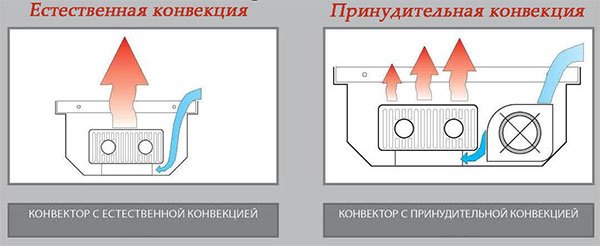
Photo 1. Operation diagram of an in-floor heating convector with natural (left) and forced (right) convection.
Operating principle
Built-in convectors are mounted in the floor around the perimeter of the room., paying special attention to the lines along the windows. In fact, they are primarily intended for the installation of this heating system. The principle of operation is based on the fact that low-temperature air naturally descends from the cold-conducting window into the convector, it is heated in the convector and pushed out into the room a new stream of cold coming down from the window.
Advantages of floor-mounted products
- Aesthetics — an indisputable advantage of underfloor heating devices. Agree, decorative grates in the floor, from which warmth blows, create much more coziness than bulky radiators.
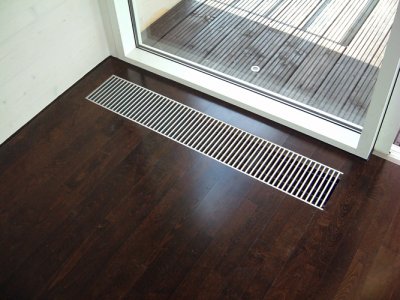
- Space is being freed up, not occupied by conventional radiators, plus we get free access to the windows and doors of the loggia or balcony.
- The heat from the convector goes exactly where it is coldest - along windows and doors.
- The room warms up much faster, than with a classical heating system.
- The equipment is lightweight and does not create a load on the foundation and floor.
- The temperature of the decorative grille does not exceed +40 °CIt is impossible to get burned.
- The underfloor convector not only heats the room, but also cools it down, replacing the air conditioner.
Flaws
- The need for proper care of the device. We will dwell on this in more detail separately a little later. Let us just note that traditional cast iron heating batteries sometimes also need to be dusted off. So this disadvantage is relative.
- Price — the devices are not cheap, especially those equipped with additional equipment.
Attention! Incompatibility with the classic heating system - you can't mount them together. Without going into technical details: neither one nor the other will work normally. Having decided to equip the room with floor convectors, carefully weigh the capabilities of the system in relation to the building that needs to be heated.
- Difficulty of installation - you will need the services of a specialist unless you are a self-taught technical genius.
Scope of application
Floor convectors (correctly selected, of course) - ideal solution for a private house or apartment (office, restaurant, etc.) with panoramic windows.
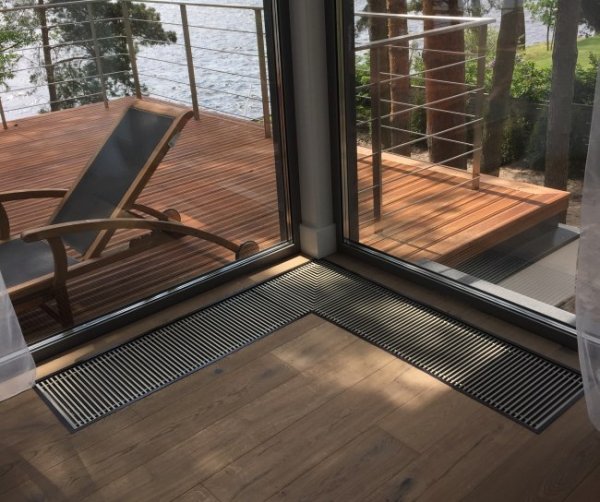
Photo 2. Floor heating convectors located in a private house near panoramic windows.
This system will be an excellent alternative to wall-mounted radiators where their installation is impossible.
The devices will also create an optimal microclimate. in swimming pools, greenhouses, winter gardens. They are effective in rooms with high humidity and can work not only for heating but also for cooling. With the help of smart electronic equipment, the temperature regime that is necessary is set in a limited space.
But there are some nuances here too. Built-in convectors cannot be used. where water can enter the heating applianceIn such a situation, special devices that remove water and condensate from the system will help.
Attention! Generally There is only one strict limitation: Built-in convectors cannot be used in rooms with aggressive environments. For example, in pools with sea water.
Types of devices
The devices are divided for electric and water — fed from the circulation circuit.
Electrical
In these devices, the heating element (heating element with plates) Powered by the electrical network. Plugged into the socket - warm. No electricity (line failure) - it got cold.
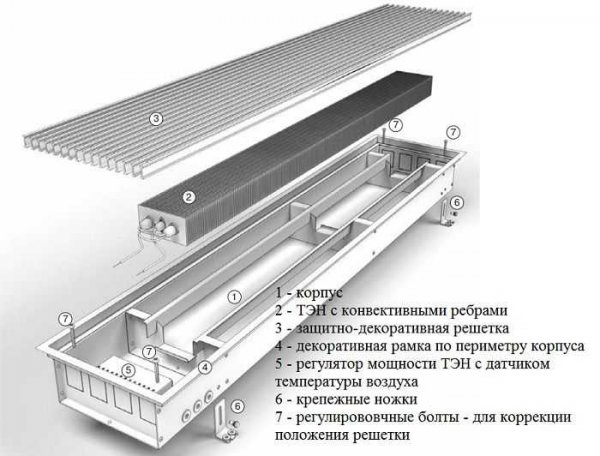
Photo 3. Diagram of the device of an in-floor electric convector. The numbers indicate the components of the device.
Powered by a circulation circuit
The operating principle of this type of floor convectors the same as the classic radiator water heating system: the coolant heated by the boiler (gas, diesel, wood) gives off heat to the air masses.
Sure, the process of heating the room is extended. But you certainly won’t freeze if the electricity goes out in your house.
Installation and connection of floor convectors
Let's take as an example the ideal option, when first the room is designed and built taking into account the subsequent equipment with built-in convectors, and only then we install them in the floor. Otherwise You definitely can't do without the help of specialists.
Installation
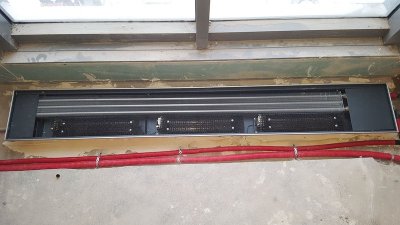
The first thing we do is prepare niches in the floor.
Please note that the devices can be mounted not only in concrete screed, but also in false floor - wooden podium.
- Niche depth. Manufacturers of devices recommend doing it by 10-20 mm greater than the height of the convector. This will allow you to align the box with the level and join it flush with the floor. It is recommended to add 5-10 cm from the dimensions of the box, so that it can be securely fastened.
Reference. It is better to place the convector in a niche so that the heat exchanger is further from the window and closer to the room - warm air will reach its destination faster.
- Distance from the window. Recommended - 5-15 cm for free air circulation. From the walls (if they are nearby) - 15-30 cm, so that excessive heat does not reach the walls.
- Curtains. Here the manufacturers avoid answering how to combine this decorative element with a convector. We act logically: first, the heating system is installed, and the curtain is adjusted to it in such a way as not to interfere with air circulation.
- Heat loss and insulation. Make sure that the insulating material is present. Otherwise, the convector will heat the floor nearby, not the room.
Connection
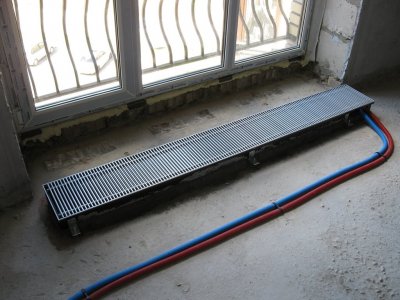
If we are talking about a water convector, then there are two ways:
- Flexible connection — flexible hoses. These are easier to clean: you can simply lift the heat exchanger and remove dust and debris.
- Hard connection — using a feed valve. It is more reliable, but less convenient to use.
Electric built-in convector is connected to the network 220 volts. The main thing: it is better to lay all the wires in advance, hiding them under the floor. It is absolutely unacceptable to lay them outside. At the same time, the cross-section and material of the wire must correspond to the passport data of the convector.
It is better to entrust installation and connection to specialists.
Popular models
There are enough manufacturers of these heating devices, but in order not to make a mistake, it is better to pay attention to popular, proven brands. This ASCOTHERM companies Kermi (Germany), Verano (Poland), Varmann (Russia) and others.
How to choose built-in appliances
Main landmarks — type of premises and heating system, ratio of building footage and device power, need for additional options. Let's take a closer look.
Types of premises and heating
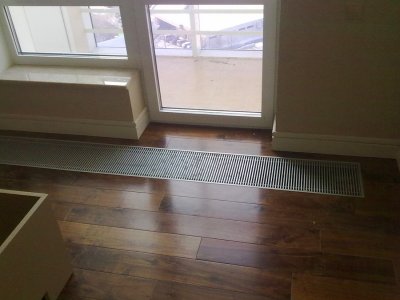
What is implied here is humidity level (regular room or swimming pool). If it is quite damp around, it is better to look at convectors with a stainless or galvanized steel body.
Although, almost all manufacturers have switched to this type of material when making boxes.
Are you planning an electric convector or a water one? It is important to take into account and measure it against the capabilities of your wallet And connection options.
Footage and power
It makes sense: The larger the heating area, the more powerful the device needs to be. But everything depends on whether the system will be the main or additional source of heat. This significantly affects the determination of power when choosing a device.
You can calculate the power like this: 40 W of power is required for 1 cubic meter of volume. We multiply them and get an approximate figure.
Ceiling height also plays an important role.The larger it is, the more powerful the device needs to be.
Additional options
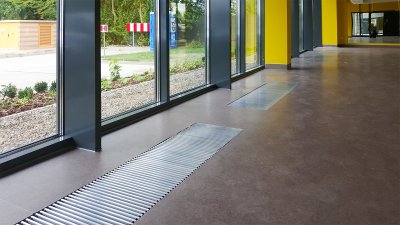
Manufacturers offer various options for additional equipment built-in convectors.
This is an air supply for natural convection and a turbocharger for forced convection, the presence of a thermostat, the ability to set a specific temperature that the device will maintain constantly, cooling and ventilation functions.
Useful video
Watch the video, which explains how to install floor convectors.
Maintenance and operation: more often and cleaner is better
Many manufacturers recommend cleaning convectors twice a year - before and after the heating season. But it is more correct to tidy up the boxes a couple of times a month.
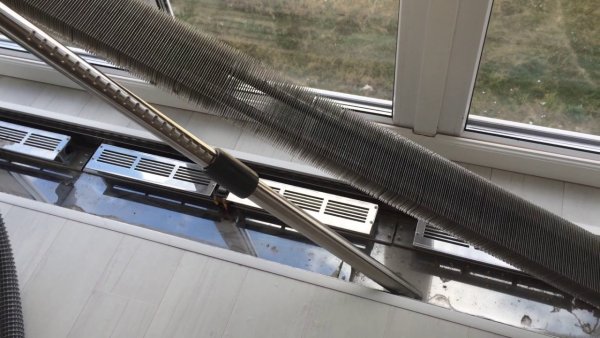
Photo 4. Cleaning the built-in convector: the protective grille of the device is raised, dust is removed using a vacuum cleaner.
Turn off the power supply And stop the supply of coolant.
Remove the decorative grille and electric fan, if there is one.
Carefully lift the heat exchanger and clean the box. and all parts with a vacuum cleaner with a narrow nozzle, if possible - wipe with a damp cloth made of soft material.
Don't forget to put the protective grille back in place. — it is prohibited to operate the device without it.






